| Baltic states synchronization with ENTSO-E grid | |
|---|---|
| Location | |
| Country | Lithuania, Latvia, Estonia |
| General direction | north-south-north |
| Ownership information | |
| Partners | Litgrid Augstsprieguma tīkls Elering |
| Construction information | |
| Commissioned | February 2025 (expected) |
| Technical information | |
| Type | overhead power line, subsea cable |
| Type of current | HVAC |
| AC voltage | 400 kV |
Baltic states synchronization with UCTE is an international electricity transmission infrastructure project to synchronize the three Baltic states (Lithuania, Latvia and Estonia) with the Synchronous grid of Continental Europe, managed by ENTSO-E, and leave the IPS/UPS transmission system managed by the BRELL (Belarus, Russia, Estonia, Latvia, Lithuania) agreement. [1] The project is expected to be completed by February 2025. [2]
The electricity systems of Estonia, Latvia and Lithuania were integrated into the IPS/UPS following the Soviet occupation of the Baltic States. IPS/UPS is largely managed centrally by Moscow. The synchronization project will allow the three Baltic States to regain full control of their electricity networks and strengthen energy security. [3] [4] According to the European Commission, the synchronization of Baltic States is a political and financial priority and therefore has allocated more than EUR 1.2 billion towards the funding of the project. [5]
In 2007 the Prime Ministers of the three Baltic States confirmed their strategic objective to become part of the continental European network. [4] In September 2018 an official application for expansion of the synchronous zone was submitted to ENTSO-E. [6] On 27 May 2019, an agreement was signed for the connection of the Baltic states to the Continental Europe synchronous electric power network operation zone. [6]
The need for synchronization became more urgent after the Russian invasion of Ukraine in 2022. Lithuanian Prime Minister Ingrida Šimonytė announced that Lithuania is seeking to speed up the process of transition and leave BRELL transmission system before 2025 with expected finalized plan made public by the end of 2023. [7]
On 22 April 2023 a stress test was scheduled in the Baltic states to test the infrastructure and operate for a day outside the IPS/UPS BRELL circle. [8] Latvia and Estonia withdrew from testing, while Lithuania successfully conducted the test and concluded that the country is ready to join Synchronous grid of Continental Europe in 2024. [9] Estonia and Latvia proposed the synchronization with European grid to be delayed to 2025 due to infrastructure not being ready. [10] President of Lithuania Gitanas Nausėda continued to pressure both Estonia and Latvia to synchronize with continental Europe in 2024, without waiting until 2025. [5] Eventually, the countries agreed to synchronize no later than February 2025. [2]
On 9 December 2015, Poland and Lithuania was commissioned LitPol Link, which was the first direct connection between Baltic states and the European grid. [11] In 2018 another proposed link with Poland via Baltic Sea was announced, called Harmony Link. [12] The total investment planned for the Harmony Link project is around €680 million, of which €493 million will come from the Connecting Europe Facility. [13] The Baltic States also have connections with the Nordic electricity grid via Nordbalt and Estlink.
NordBalt is a submarine power cable between Klaipėda in Lithuania and Nybro in Sweden. The purpose of the cable is to facilitate the trading of power between the Baltic and Nordic electricity markets, and to increase the supply and energy security in both markets.
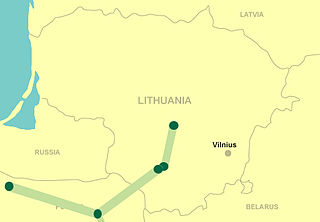
LitPol Link is an electricity link between Poland and Lithuania which connects the Baltic transmission system to the synchronous grid of Continental Europe. It has a capacity of 500 MW and since 2021 it can operate in a synchronous regime.
ENTSO-E, the European Network of Transmission System Operators, represents 40 electricity transmission system operators (TSOs) from 36 countries across Europe, thus extending beyond EU borders. ENTSO-E was established and given legal mandates by the EU's Third Package for the Internal energy market in 2009, which aims at further liberalising the gas and electricity markets in the EU. Ukrainian Ukrenergo became the 40th member of the association on 1 January 2024.

The synchronous grid of Continental Europe is the largest synchronous electrical grid in the world. It is interconnected as a single phase-locked 50 Hz mains frequency electricity grid that supplies over 400 million customers in 24 countries, including most of the European Union. In 2009, 667 GW of production capacity was connected to the grid, providing approximately 80 GW of operating reserve margin. The transmission system operators operating this grid formed the Union for the Coordination of Transmission of Electricity (UCTE), now part of the European Network of Transmission System Operators for Electricity (ENTSO-E).
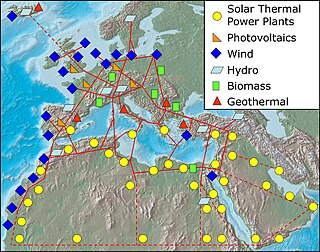
The SuperSmart Grid (SSG) is a hypothetical wide area electricity network connecting Europe with northern Africa, the Middle East, and the IPS/UPS system of CIS countries. The system would unify super grid and smart grid capabilities into a comprehensive network. There are no planned locations for infrastructure or schedule explicitly for the SSG; the name is used to discuss the economic and technological feasibility of such a network and ways that it might gain political support.

A wide area synchronous grid is a three-phase electric power grid that has regional scale or greater that operates at a synchronized utility frequency and is electrically tied together during normal system conditions. Also known as synchronous zones, the most powerful is the Northern Chinese State Grid with 1,700 gigawatts (GW) of generation capacity, while the widest region served is that of the IPS/UPS system serving most countries of the former Soviet Union. Synchronous grids with ample capacity facilitate electricity trading across wide areas. In the ENTSO-E in 2008, over 350,000 megawatt hours were sold per day on the European Energy Exchange (EEX).
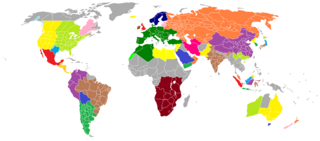
The IPS/UPS is a wide area synchronous transmission grid of some CIS countries, with a common mode of operation and centralized supervisory control. It has an installed generation capacity of 300 gigawatts, and produces 1,200 terawatt-hours (TWh) per year for its 280 million customers. The system spans eight time zones.

Burshtyn TES is a coal-fired power plant of Zakhidenergo located in Ivano-Frankivsk Raion 6 kilometres (3.7 mi) south-east from Burshtyn, Ivano-Frankivsk Oblast, Ukraine. It was built in the Soviet era and is now part of Rinat Akhmetov's holdings.

Nord Pool AS is a pan-European power exchange. Nord Pool has a main office in Oslo and further offices in Stockholm, Helsinki, Tallinn and London. The company is owned by the European exchange operator Euronext as well as TSO Holding, which represents the continental Nordic and Baltic countries' transmission system operators. Nord Pool has two subsidiaries, Nord Pool AB and Nord Pool Finland Oy.

Elering AS is a national transmission system operator for electricity and natural gas with headquarters in Tallinn, Estonia. The managing director of Elering is Taavi Veskimägi.
Energy in Estonia has heavily depended on fossil fuels. Finland and Estonia are two of the last countries in the world still burning peat.
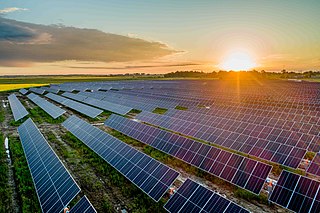
Lithuania is a net energy importer. In 2019 Lithuania used around 11.4 TWh of electricity after producing just 3.6 TWh.
Latvia is a net energy importer. Primary energy use in Latvia was 49 TWh, or 22 TWh per million persons in 2009. In 2018, electricity consumption per capita was 3731 kWh.
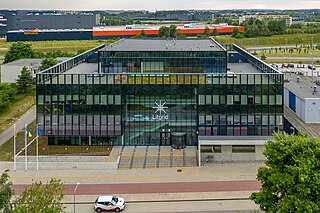
Litgrid AB is a Lithuanian electricity transmission system operator that operates Lithuania's electricity transmission grid. Litgrid is responsible for the integration of the Lithuanian electricity system into the European electricity infrastructure and the common electricity market.

Augstsprieguma Tīkls AS (AST) is an independent electricity transmission state system operator in Latvia. It operates power systems with voltages of 110 kV and above, which is leased from Latvenergo. It is also the main shareholder of Conexus Baltic Grid, a unified natural gas transmission and storage operator in Latvia.

Gas Interconnection Poland–Lithuania (GIPL) is a gas pipeline between Poland and Lithuania. The pipeline was commissioned and started commercial operation on 1 May 2022. The length of the pipeline is 508 km (316 mi) and the natural gas can flow both directions. The pipeline will run from Jauniūnai natural gas compression station (GCS) in eastern Lithuania to the Hołowczyce GCS station in eastern Poland.

The Šiauliai–Jelgava power line is an electricity link (interconnector) in the Baltic transmission system between Lithuania and Latvia. The overhead power line is one of seven interconnections between the two countries and one of the four 330 kV power transmission lines between Lithuania and Latvia.

The Nordic regional group of ENTSO-E is a synchronous electrical grid composed of the electricity grids of Norway, Sweden, Finland and the eastern part of electricity sector in Denmark. The grid is not synchronized with the synchronous grid of Continental Europe, but has a number of non-synchronous DC connections with that as well as other synchronous grids. Gotland is not synchronized with the Swedish mainland either, as it is connected by HVDC.
Harmony Link is a planned electricity link between Lithuania and Poland. The purpose of the cable is to finish the transition of the Baltic states from IPS/UPS to the synchronous grid of Continental Europe.
Ukrenergo is an electricity transmission system operator in Ukraine and the sole operator of the country's high-voltage transmission lines. It is 100% owned by Ukrainian government.